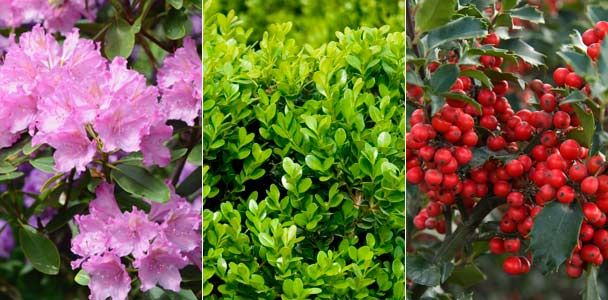Creating a beautiful and thriving garden depends on selecting the right shrubs. In this article, we’ll explore a curated list of favorite shrubs from Wesley Rouse, owner of Pine Meadow Gardens Inc., a renowned design-build landscape firm in western Connecticut. These reliable, easy-care shrubs work in various garden settings and thrive in all seasons, making them great for any gardener regardless of skill or climate.
1. Rhododendron: A Perky, Colorful Shrub

Zones: 3–9
Why he plants it: “For its bulky background foliage year-round, with the perk of spring color.”
Details: Rhododendrons are a diverse family of plants that offer something for every landscape. These shrubs feature showy, often fragrant flowers and evergreen foliage across varieties. With proper care, rhododendrons can provide a stunning backdrop and create a lush, woodland-like atmosphere in your garden.
Habit: Depending on the variety, rhododendrons can reach 6 to 20 feet high and up to 25 feet wide.
Care: Grow rhododendrons in moist, fertile, humus-rich, acidic soil with a pH of 4.5–5.5. They prefer dappled shade and require a 2-inch mulch covering to maintain even moisture for their surface roots. Regular pruning after flowering can help maintain shape and encourage bushier growth. Rhododendrons also benefit from an annual application of compost or organic fertilizer to nourish their nutrient-rich soil.
2. Drooping Leucothoe: A Deer-proof Shrub

(Leucothoe fontanesiana)
Zones: 4–7, though some cultivars, such as ‘Girard’s Rainbow,’ are hardy to Zone 9
Why he plants it: “It serves as a deer-proof groundcovering shrub.”
Details: Drooping Leucothoe is an excellent choice for naturalizing and massing under large trees or on shady slopes. Its fragrant white flowers bloom in spring, complemented by deep-green, leathery leaves that take on a purple hue in winter. This shrub pairs well with rhododendrons and adds texture to shaded areas of the garden.
Habit: Reaches 3–4 feet high and wide.
Care: Plant in well-drained soil in partial sun. Apply acid fertilizer after blooming to maintain soil pH. Water regularly during the first growing season to establish strong roots and provide a 3-inch layer of mulch to retain moisture and suppress weeds. Pruning is generally minimal, but removing old or damaged branches can help maintain the shrub’s shape and health.
3. Redvein Enkianthus: Shrub With a Seasonal Color Change
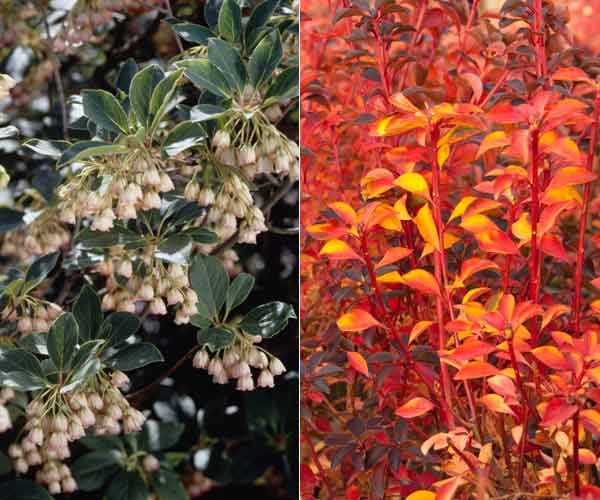
(Enkianthus campanulatus)
Zones: 4–7
Why he plants it: “In spring, this shrub bears lily-of-the-valley-like flowers; in autumn, the foliage is on fire.”
Details: Redvein Enkianthus is a large deciduous shrub with a distinctive layered branching structure. Its small leaves turn vibrant shades of red, orange, and yellow in autumn, creating a spectacular display. The shrub’s nodding clusters of small cream or reddish bell-shaped flowers add charm from late spring to mid-summer. Whether incorporated into a mixed border or used as a striking specimen plant, Redvein Enkianthus makes a statement in the garden.
Habit: Reaches 6–15 feet high and wide, depending on the zone.
Care: Grow in moist, organically rich, well-drained, peaty, acidic soil in full sun to part shade. Prune immediately after flowering to maintain shape and size, as it blooms on the previous year’s growth. Provide adequate space for the shrub to reach its full potential without crowding neighboring plants. Mulching and winter protection in colder regions can also help this shrub thrive year-round.
4. Dwarf Korean Lilac ‘Palibin’: A Resistant Addition to Your Hedge
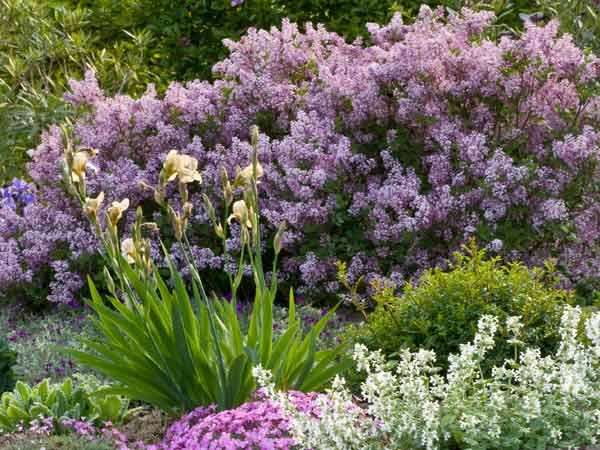
(Syringa meyeri ‘Palibin’)
Zones: 3–7
Why he plants it: “This is a mildew-resistant lilac that forms a dense shrub; it is easily clipped into orbs or hedges to look swell even after the spring flowers are finished.”
Details: This dwarf-spreading deciduous lilac is known for its profuse blooming and compact size. Its reddish-purple buds open to reveal fragrant pale-lilac flowers, typically in mid-May. The ‘Palibin’ cultivar is particularly valued for its resistance to powdery mildew, a common problem in many lilac varieties. It’s an excellent choice for small gardens or as part of a mixed shrub border.
Habit: Reaches 4–5 feet high and wide.
Care: Plant in average, dry to medium well-drained soil, in partial to full sun for best blooming. Remove faded flower heads before seeds are set to encourage more blooms the following year. Prune for shape or size immediately after flowering to maintain its compact form.
5. Boxwood: An Evergreen Shrub
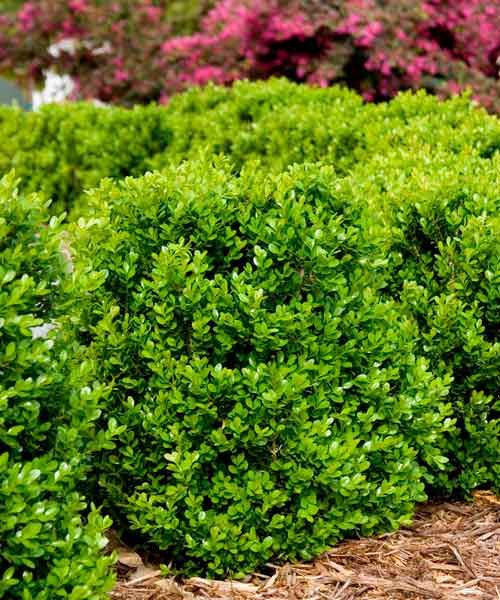
(Buxus hybrids)
Zones: 4–9, depending on the species
Why he plants it: “Winter, summer, whenever—these evergreens form a lasting hedge or accent plant.”
Details: Boxwoods are versatile broadleaf evergreens that offer year-round structure and interest in the landscape. With over 90 species available, there’s a boxwood suitable for nearly every garden situation. From the small, slow-growing English boxwood to modern hybrids bred for specific climates, these shrubs can be shaped into formal hedges or left to grow naturally as accent plants. They are also deer-resistant, making them a reliable choice in areas with high deer populations.
Habit: Varies depending on the species, ranging from compact dwarf varieties to larger specimens.
Care: Boxwoods should be grown in loamy, loose, well-drained soil in full to partial sun. They benefit from periodic shearing to maintain their shape, but they can also be left to grow naturally for a more relaxed appearance. Apply mulch around the base to retain moisture and suppress weeds. Make sure boxwoods are planted in areas with good air circulation as this reduces the risk of fungal diseases.
6. Blue Mist Shrub
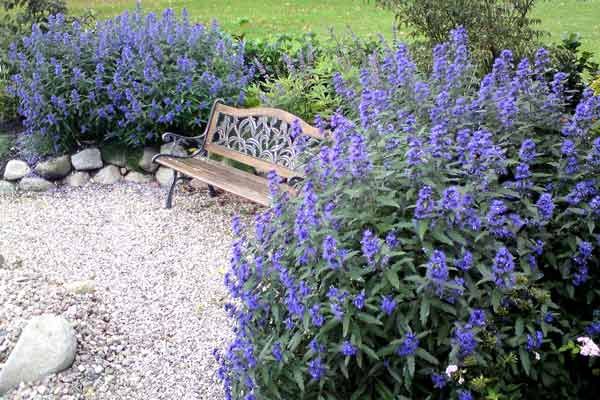
(Caryopteris x clandonensis)
Zones: 5–9
Why he plants it: “A deer-resistant shrub that blooms when you least expect to see blue: in late summer.”
Details: Blue Mist Shrub, also known as Bluebeard, is a valuable addition to the late summer garden. Its mounding habit makes it perfect as a low-border plant or in mass plantings. The shrub produces hundreds of blue flower spikes, each about a foot long, creating a stunning display when many other plants have finished blooming. It adds color and attracts pollinators, including bees and butterflies.
Habit: Reaches 2–3 feet high and wide.
Care: Plant in very well-drained sandy soil in full sun. This drought-tolerant shrub thrives on neglect, making it an excellent choice for low-maintenance gardens. Cut back in late winter to promote strong, dense growth and abundant blooms. However, avoid excessive watering or fertilizing, which can reduce the plant’s vigor and flowering.
7. Blue Holly: A Shrub to Feed the Birds
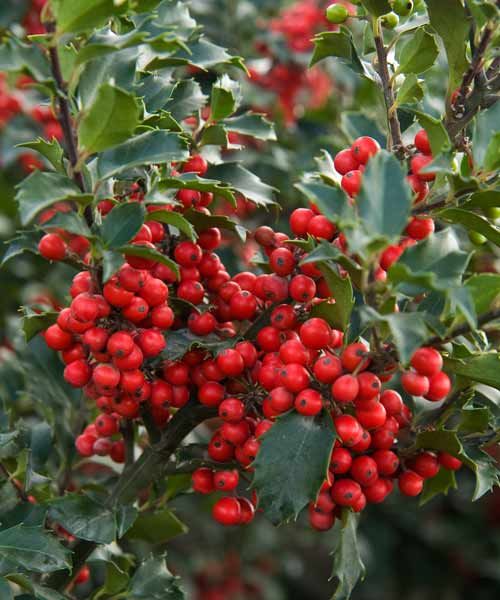
(Ilex x meserveae)
Zones: 4–7
Why he plants it: “It not only gives year-round structure but also serves berries to the birds.”
Details: Blue Holly, named for its glossy blue-green leaves, is a dense, vigorous shrub that provides year-round interest. Female plants produce shiny red berries that attract birds and add winter color to the garden. Meserve hybrids require a pollinator to set fruit, so planting both male and female cultivars is necessary for berry production. You can use them as privacy screens, hedge plants, or standalone specimen plants.
Habit: Reaches 10 feet high and wide.
Care: Grow in average, moist, acidic, organic soil with good drainage, in full sun to part shade. Blue Holly has good winter hardiness, making it suitable for colder climates. Prune in early spring, just before new growth begins to maintain shape and size. Mulching around the base helps retain moisture and regulates soil temperature.
8. Butterfly Bush
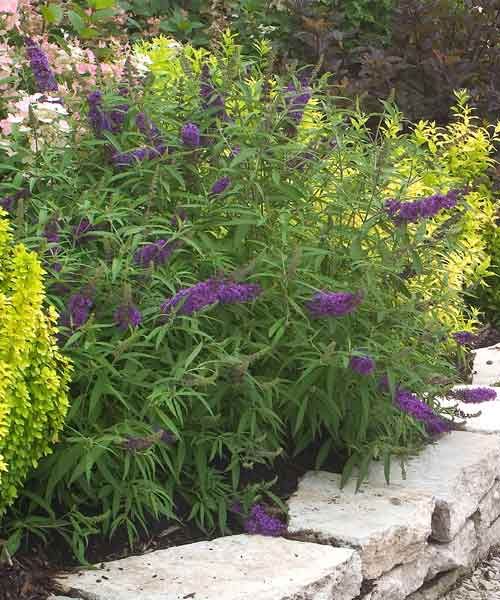
(Buddleia davidii)
Zones: 5–10
Why he plants it: “For a long spate of blossoms that bring in pollinators, such as bees and butterflies, by the drove.”
Details: Butterfly Bush is a tough woody shrub known for its large, fragrant, and colorful flowers, which attract a variety of pollinators to the garden. These long-blooming shrubs provide a valuable nectar source for butterflies, bees, and hummingbirds throughout the summer months. However, it’s important to note that Butterfly Bushes can be invasive in some areas, so check local restrictions before planting. They can serve as striking focal points in your garden or be combined with other shrubs and perennials for added diversity.
Habit: The size varies depending on the cultivar, with some compact varieties reaching only 3-4 feet, while others can grow up to 10–12 feet tall.
Care: Plant in well-drained, slightly alkaline soil (pH of 6.0–7.0) in full sun for adequate flowering. Apply a 2-inch layer of organic mulch to retain moisture and suppress weeds. Prune in spring to 2 to 3 feet to stimulate new growth and maintain the plant’s shape. Regular deadheading encourages continuous blooming throughout the season. Incorporating organic matter into the soil before planting can also boost its health and vigor.
Choosing the Right Shrubs for Your Garden
When selecting shrubs for your garden, consider factors such as your climate zone, soil type, and available sunlight. It’s also important to think about the mature size of the shrubs and how they will fit into your overall landscape design. By choosing a variety of shrubs with different blooming times and foliage characteristics, you can create a garden with year-round interest and appeal. Use a mix of evergreen and deciduous shrubs for continuous visual interest and habitat for wildlife.
Maintaining Healthy Shrubs
To keep your shrubs healthy and thriving, follow these general care tips:
- Apply a layer of organic mulch around the base of shrubs to retain moisture and suppress weeds
- Choose disease-resistant varieties to minimize maintenance needs
- Fertilize as needed, following specific recommendations for each shrub variety
- Monitor for pests and diseases and address any issues promptly
- Prune at the appropriate time for each species to maintain shape and encourage healthy growth
- Water deeply and regularly, especially during the first growing season
